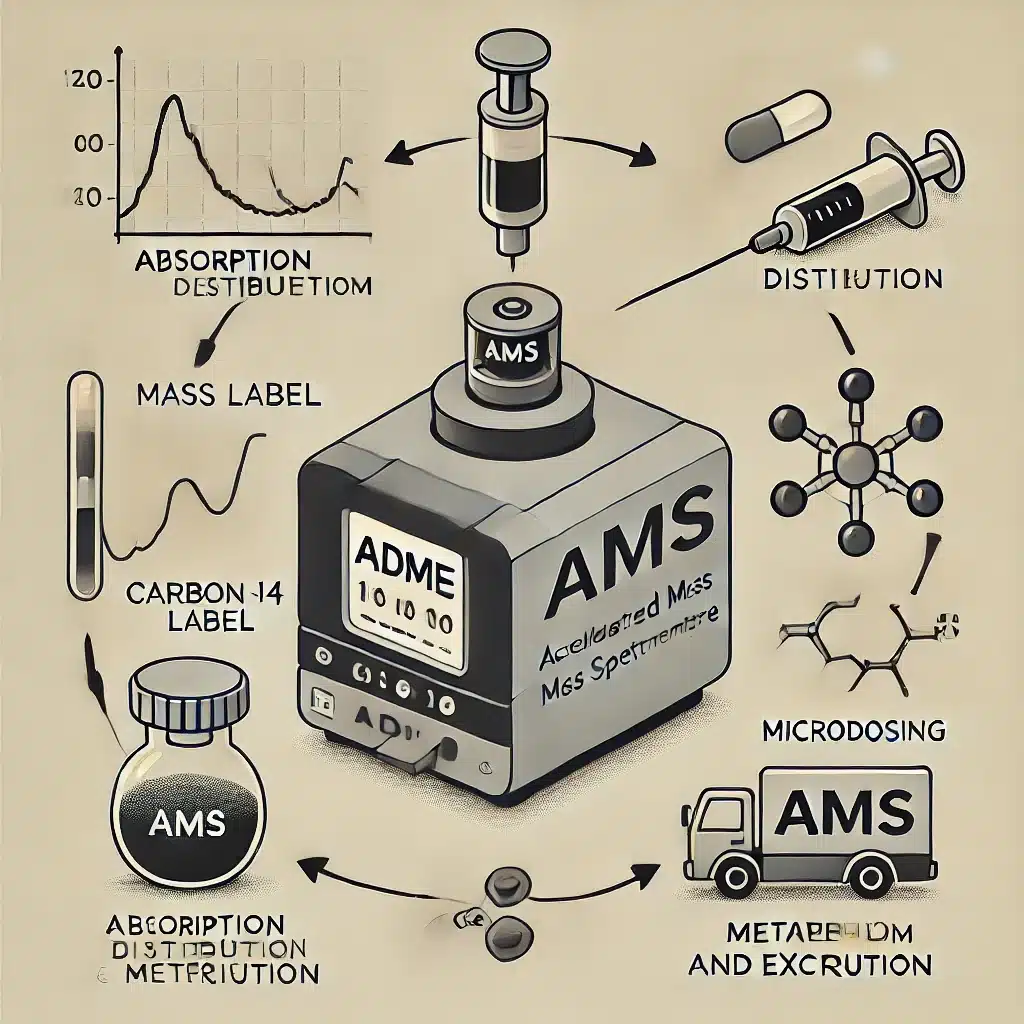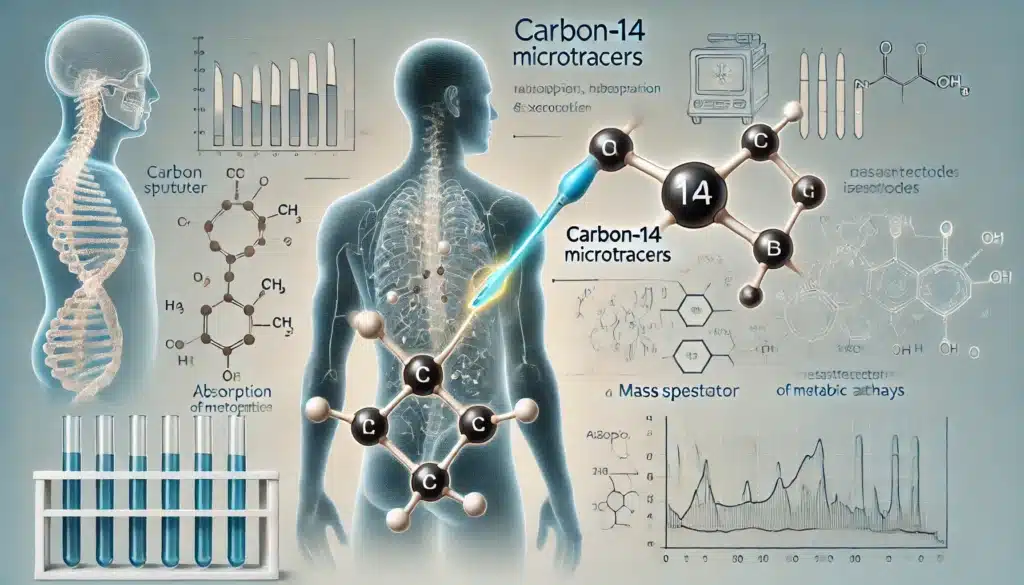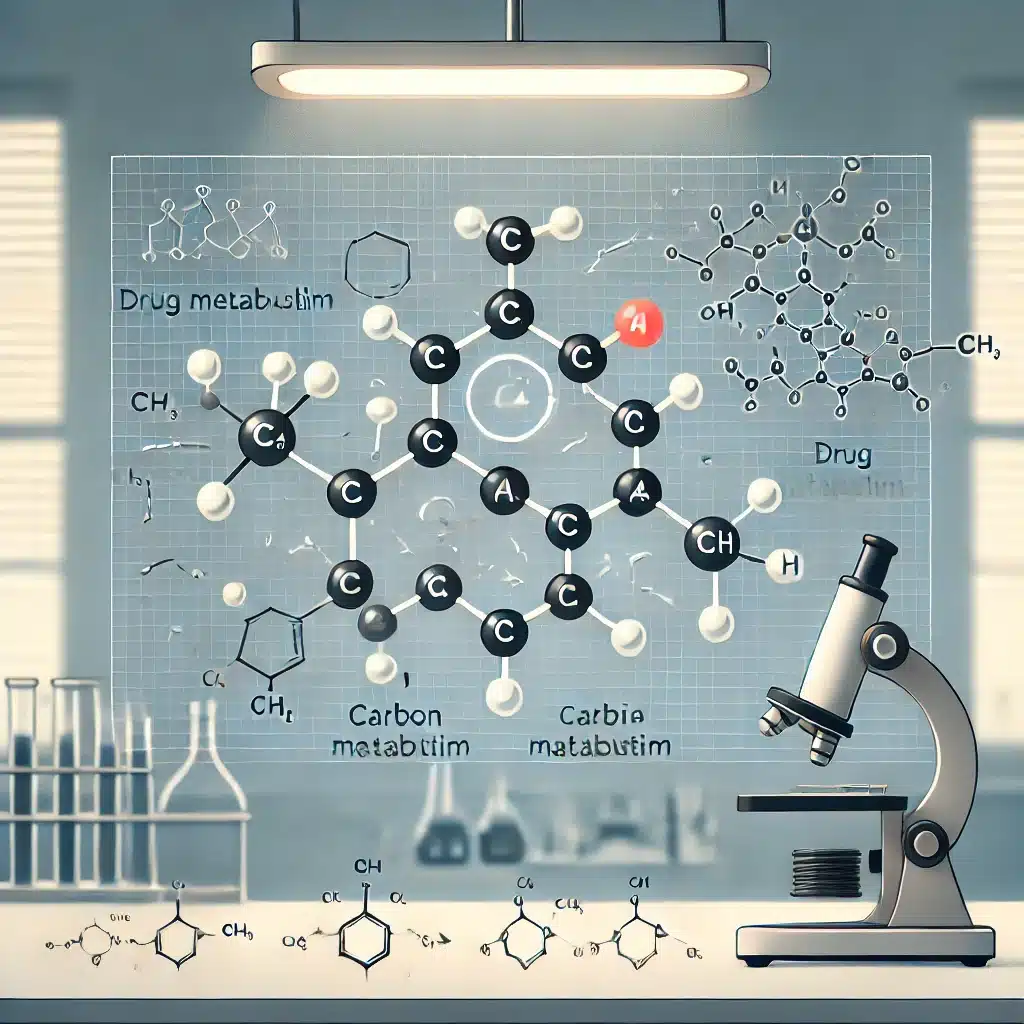Summary: Carbon-14 radiolabelling plays a crucial role in absorption, distribution, metabolism, and excretion (ADME) studies, especially in pharmaceutical research. This technique allows researchers to trace drug molecules within biological systems, offering precise insights into how a drug behaves within the body. Understanding carbon-14 labelling, its methodologies, applications, and associated challenges are vital for developing safe and effective drugs. This article explores the mechanisms of carbon-14 labelling, its benefits in ADME studies, typical experimental designs, safety considerations, and future perspectives.
Introduction to Carbon-14 Radiolabelling in ADME Studies
ADME studies are essential in drug discovery and development, providing insights into how drugs are absorbed, distributed, metabolised, and excreted within the body. Carbon-14 (14C) radiolabelling has been a gold standard in ADME studies for several decades, primarily due to its ability to trace complex metabolic pathways with high sensitivity and precision. Given its half-life of approximately 5,730 years, carbon-14 offers longevity for long-term studies while emitting relatively low-energy beta radiation, making it manageable in laboratory settings.
The Chemistry of Carbon-14 Radiolabelling
Carbon-14, a naturally occurring isotope of carbon, is incorporated into drug molecules in a way that maintains the molecule’s native structure. This ensures the labelled compound behaves identically to its non-labelled counterpart in biological systems, allowing accurate tracking of the drug’s journey through the body. Radiolabelling with carbon-14 generally involves the substitution of a stable carbon atom in the drug molecule with carbon-14.
Methods of Carbon-14 Labelling
The synthesis of carbon-14-labelled compounds can be done through various methods, including:
Direct labelling – Involves introducing carbon-14 directly into the molecule.
Isotopic exchange – Substituting a specific atom with carbon-14 in an existing structure.
Biosynthetic labelling – Incorporating carbon-14 during the biosynthesis of the target compound.
The choice of method depends on the molecular structure, the position of the carbon atom to be labelled, and the metabolic stability required.
Importance of Carbon-14 Radiolabelling in ADME Studies
Carbon-14 radiolabelling provides high sensitivity and allows for the tracking of a compound’s metabolic profile even at low concentrations. Unlike non-radioactive labelling methods, carbon-14 does not require complex analytical detection equipment, such as mass spectrometers, making it highly cost-effective and accessible.
Precision in Absorption Studies
In absorption studies, carbon-14-labelled drugs are administered to understand how effectively a drug is absorbed into the bloodstream. By tracking carbon-14, researchers can determine the extent of absorption, bioavailability, and the rate at which a compound crosses biological membranes.
Distribution Analysis
Carbon-14 radiolabelling helps elucidate the distribution of a compound across various tissues and organs. This information is crucial for understanding potential drug accumulation in specific tissues, which could lead to toxicity.
Metabolism Investigation
Metabolism studies using carbon-14 reveal how a drug is transformed within the body. By tracing carbon-14-labelled metabolites, scientists can identify metabolic pathways and determine if any harmful metabolites are formed.
Excretion Pathways
Carbon-14 radiolabelling is instrumental in understanding how drugs are eliminated from the body. Both urinary and faecal excretion can be monitored, providing insights into renal and hepatic clearance mechanisms.
Experimental Design and Methodologies in Carbon-14 Radiolabelling ADME Studies
Designing carbon-14 ADME studies requires careful consideration of dosage, sample collection, and analytical methodologies.
Dose Selection
Typically, a low dose is administered in carbon-14 studies due to the sensitivity of radiolabel detection. Dose selection also depends on the drug’s toxicity and anticipated distribution within the body. Microdosing studies, which involve administering subtherapeutic doses of a compound, are particularly effective when combined with carbon-14 radiolabelling.
Sample Collection and Analysis
Blood, urine, faeces, and tissue samples are collected to track carbon-14. Radioactivity in these samples is measured using techniques such as liquid scintillation counting (LSC) and accelerator mass spectrometry (AMS), which provide precise quantification of radiolabelled compounds even at low concentrations.
Analytical Techniques
Liquid Scintillation Counting (LSC): This method involves dissolving the radioactive sample in a scintillation fluid, which emits light when interacting with beta particles. LSC is a widely used, sensitive method for quantifying carbon-14.
Accelerator Mass Spectrometry (AMS): AMS measures the carbon-14 to carbon-12 ratio in samples, offering exceptionally high sensitivity and the ability to quantify minute amounts of carbon-14. It is especially useful in microdosing studies.
Applications of Carbon-14 Radiolabelling in Drug Development
Drug-Drug Interaction Studies
Carbon-14 radiolabelling allows researchers to study potential interactions between drugs when administered together. By tracing the labelled compound, scientists can assess whether the presence of a second drug affects the ADME profile of the primary compound.
Toxicology and Safety Assessment
Carbon-14 radiolabelling is a crucial tool in assessing the safety of new drugs. It helps in identifying any toxic metabolites that may be generated during metabolism, thereby ensuring a comprehensive safety evaluation before clinical trials.
Human Microdosing Studies
Microdosing with carbon-14-labelled drugs is a growing approach in early drug development. It allows researchers to evaluate pharmacokinetics and preliminary safety data in humans without the ethical concerns of administering higher doses.
Environmental Impact Assessment
Beyond pharmaceuticals, carbon-14 radiolabelling is also used to study the environmental impact of drugs, particularly how pharmaceutical compounds are metabolised and excreted. This helps evaluate the potential ecological consequences of drug residues in wastewater and soil.
Safety Considerations in Carbon-14 Radiolabelling Studies
While carbon-14 radiolabelling is relatively safe, precautions are essential to manage radioactive material appropriately.
Laboratory Protocols
Strict protocols govern the handling, storage, and disposal of carbon-14-labelled materials. Laboratories are required to follow guidelines to prevent contamination, including the use of dedicated equipment and controlled access areas.
Radiation Exposure and Dosimetry
Although carbon-14 emits low-energy beta radiation, continuous monitoring of laboratory personnel’s exposure is essential. Dosimeters and personal protective equipment (PPE) are used to minimise any risk associated with prolonged exposure.
Waste Disposal
Carbon-14 waste disposal must comply with environmental and regulatory standards. Radioactive waste is categorised and stored in designated containers until it can be disposed of through authorised facilities, ensuring minimal environmental impact.
Limitations and Challenges in Carbon-14 Radiolabelling ADME Studies
Carbon-14 radiolabelling presents some challenges, particularly in complex systems and low-yield synthesis reactions.
High Cost and Synthesis Challenges
Carbon-14-labelled compounds are costly to produce, as they often require specialised synthesis techniques and equipment. Additionally, synthesis can be technically challenging due to the limited availability of carbon-14 and the need to maintain high purity.
Sensitivity to Environmental Factors
Radiolabelling experiments can be sensitive to external factors like temperature and pH, which may affect the stability of the labelled compound. This necessitates careful experimental design to minimise any artefacts caused by such factors.
Ethical and Regulatory Considerations
Using radiolabelled compounds in human studies raises ethical considerations, even at low doses. Regulatory approval is essential for studies involving carbon-14 to ensure that they meet the stringent safety and ethical standards required for human and environmental protection.
Future Directions in Carbon-14 Radiolabelling and ADME Studies
As drug development advances, carbon-14 radiolabelling is likely to be complemented by other innovative methodologies.
Advancements in Accelerator Mass Spectrometry (AMS)
AMS technology is continually improving, offering even higher sensitivity for detecting carbon-14-labelled compounds. This progress is particularly valuable in microdosing studies, where only trace amounts of radiolabelled material are used.
Integration with Non-Radiolabelled Methods
Combining carbon-14 radiolabelling with non-radiolabelled techniques, such as stable isotope labelling, can provide complementary data that enhances the understanding of drug metabolism and pharmacokinetics.
Enhanced Computational Modelling
Computational models are becoming increasingly sophisticated, allowing researchers to predict ADME properties with greater accuracy. These models can be validated with carbon-14 radiolabelling data, creating a synergistic approach to drug metabolism research.
Environmental Impact Studies
With growing concerns about pharmaceuticals in the environment, carbon-14 radiolabelling offers potential for further research into the environmental fate of drugs. This may lead to improved drug formulations that are more biodegradable and have reduced ecological impact.
Case Studies and Real-World Applications of Carbon-14 Radiolabelling in ADME Studies
To illustrate the practical utility of carbon-14 radiolabelling in ADME studies, examining specific case studies highlights the technique’s diverse applications and real-world impact.
Case Study: Carbon-14 in Anti-Cancer Drug Development
In developing an innovative anti-cancer agent, researchers utilised carbon-14 radiolabelling to assess the drug’s distribution and metabolism. By administering a 14C-labelled version of the drug in early clinical trials, researchers tracked its biodistribution to confirm targeted delivery to tumour sites. The study revealed that the drug achieved high concentrations in tumour tissues while being rapidly cleared from healthy tissues, suggesting a favourable safety profile and enabling further clinical development.
Case Study: Microdosing in Cardiovascular Drug Development
In the development of a novel cardiovascular drug, carbon-14 radiolabelling played a pivotal role in understanding the drug’s pharmacokinetics through a microdosing study. A low-dose, carbon-14-labelled form of the drug was administered to human volunteers, and AMS was employed to detect trace amounts in blood samples. This approach helped researchers establish the drug’s half-life and distribution pattern at an early stage, ultimately accelerating the drug’s progression through the pipeline by providing early PK data in humans.
Environmental Case Study: Tracing Antibiotics in Aquatic Systems
An environmental application involved carbon-14 radiolabelling to study the degradation of antibiotics in wastewater treatment plants. Researchers added 14C-labelled antibiotics to treatment systems and monitored how the compounds interacted with microorganisms in the water. The study found that certain antibiotics resisted complete degradation, posing potential risks to aquatic ecosystems. Insights from this study informed strategies for improved wastewater management and antibiotic formulation to minimise ecological impact.
Technological Innovations and the Future of Carbon-14 Radiolabelling
Carbon-14 radiolabelling continues to evolve alongside technological innovations, enhancing its applicability and versatility in ADME studies.
High-Resolution Imaging Techniques
Improvements in imaging technology are enabling more detailed visualisation of radiolabelled compounds within tissues and organs. Techniques such as positron emission tomography (PET) and autoradiography, when combined with carbon-14 labelling, allow researchers to see exactly where a drug accumulates within the body, adding a new dimension to tissue distribution studies.
Improved Radiochemistry Techniques
Ongoing advancements in radiochemistry are enhancing the efficiency and safety of synthesising carbon-14-labelled compounds. Novel methodologies allow for more targeted labelling at specific molecular sites, improving the accuracy of tracing studies and reducing the risk of metabolic transformations that could interfere with the study.
Combination with Molecular Biology Techniques
Carbon-14 radiolabelling is increasingly being combined with genetic and molecular biology tools to study interactions between drugs and specific enzymes or receptors. By labelling drugs and using molecular assays, researchers can assess binding affinity, enzyme inhibition, and receptor occupancy, yielding mechanistic insights that are valuable for targeted drug design.
Applications in Personalised Medicine
In personalised medicine, carbon-14 radiolabelling has the potential for studying individual variations in drug metabolism and response. By conducting microdosing studies with radiolabelled drugs, researchers can gain insights into how genetic differences impact ADME processes, leading to more tailored and effective treatments for individual patients.
Ethical and Regulatory Frameworks for Carbon-14 Radiolabelling
The use of carbon-14 in ADME studies is regulated to ensure participant safety and environmental protection.
Regulatory Requirements for Human Studies
In human studies, carbon-14 labelling is subject to strict regulatory standards set by bodies like the Medicines and Healthcare products Regulatory Agency (MHRA) in the UK and the Food and Drug Administration (FDA) in the United States. These agencies require comprehensive risk assessments, including dose calculations, radiological impact analyses, and detailed monitoring plans, before studies can proceed.
Environmental Regulations
Environmental regulations govern the disposal and handling of carbon-14 waste, particularly when it involves pharmaceutical and environmental applications. Agencies require labs to follow strict protocols for storing, tracking, and disposing of radiolabelled materials, with a focus on minimising contamination risks.
Ethical Considerations in Microdosing
Microdosing studies with carbon-14 radiolabelling present ethical considerations, especially when performed on vulnerable populations. Ethical review boards assess such studies to ensure the minimal risk to participants, with careful consideration of the necessity and design of the research. Ethical frameworks support informed consent and the ethical use of radiolabelled compounds to uphold participant autonomy and safety.
Conclusion: Impact and Future Potential of Carbon-14 Radiolabelling in ADME Research
Carbon-14 radiolabelling has solidified its place as a cornerstone technique in ADME studies, providing precise, reliable data on drug metabolism, distribution, and excretion. From its role in pharmaceutical research to its impact on environmental studies, carbon-14 labelling continues to be invaluable for exploring complex biological interactions with unparalleled accuracy. As technology advances and regulatory frameworks adapt, carbon-14 radiolabelling is likely to become increasingly integrated into a wide range of applications, contributing to safer, more effective drug development and a deeper understanding of environmental pharmacology.
In the future, the synergy between carbon-14 radiolabelling and emerging tools like computational modelling, genomics, and advanced imaging techniques promises to enhance our knowledge of drug behaviour and interactions. With these innovations, carbon-14 radiolabelling will continue to play a pivotal role in advancing both medical and environmental sciences, driving progress in precision medicine and sustainable pharmaceutical development.
Disclaimer
The content of this article, The Role of Carbon-14 Radiolabelling in ADME Studies, published by Open Medscience on 28 October 2024, is intended for informational and educational purposes only. It does not constitute professional advice, diagnosis, or treatment, and should not be used as a substitute for consultation with qualified professionals in radiochemistry, pharmacology, or regulatory affairs. While every effort has been made to ensure the accuracy and currency of the information provided, Open Medscience makes no representations or warranties regarding the completeness, reliability, or suitability of the content for any purpose. Any use of radiolabelled materials, including carbon-14, must comply with applicable safety guidelines, ethical standards, and regulatory requirements. Readers are advised to consult relevant regulatory bodies and institutional policies before undertaking studies involving radioactive substances. Open Medscience disclaims any liability for loss, injury, or damage arising from the use of this information.




